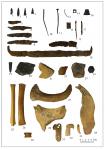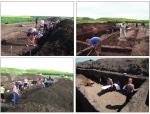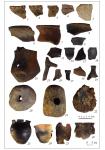Summary (English)
In 2014, excavation site 2 was placed near the eastern entrance to the hillfort, between the rampart and the ash hills. Previously, huge storage for keeping fertilizers stayed here. Despite that, a cultural layer up to 1 m thick was detected at this place. In total, 141 m2 was dug out within the excavation trenches where the researchers explored six household pits and collected more than 10 thousand artefacts.
Pit 1 measuring 1.5 in diameter and 2.1 deep. It is distinguished with pieces of carcasses discovered at the upper part of the object. Fragments of the Greek amphorae are dated by the late 6th – early 5th c. BC.
Pit 2 measuring 2.4 × 1.95 m and 2.5 m deep had a posthole at the centre of it. Possibly it was a small household cellar or a storage. A skeleton of a pig that possibly was sacrificed, laid at the bottom in the corner. The most notable materials from this pit are the pieces of iron ore and amphorae fragments with traces of repairing.
Pit 3 measuring 2 m in diameter and 1.9 m deep. It is distinguished by a find of a pendant made from a dog fang.
Pit 4 measuring 1.6 × 1.35 m and 2.3 m deep. It was filled with layers of ash mixed with black soil. Besides the mass material, such as pottery shreds, fragments of a clay altar decorated with grooves on the outer surface, were found here.
Pit 5 measuring 2.2 × 1.95 m and 2.9 m deep. It had 4 stairs dug out in the clay walls that go down the spiral to the bottom. Perhaps, it was a small household cellar or storage that after abandoning was dumped with ash and household wastes.
The majority of the finds come from the cultural layer. It was a lot of fragments of pottery and even the whole broken wares. Also, a lot of bone and horn tools, such as pieces of psalia, diverse beads, pins and even a bow tip were detected here. Greek wares collected on the site originated from different Mediterranean centres such as Klazomenai, Chios, Lesbos and Thasos. Especially interesting are the fragments of black-glazed North-Ionian jar and rare South-Ionian oenochoe that dates by the late 7th c. BC.
Besides that, some materials of the pre-Scythian period were found at the lowest parts of the cultural layer. Mostly, these are the pottery fragments decorated with stamped and carved geometrical ornament.
- Shelekhan Oleksandr - Institute of Archaeology, National Academy of Sciences of Ukraine
Director
- Iryna Shramko - V.N. Karazin Kharkiv National University
- Stanislav Zadnikov - V.N. Karazin Kharkiv National University
Team
Research Body
- Bilsk Historical and Cultural Reserve
- V.N. Karazin Kharkiv National University






![Download [PDF]](/excavation/skins/fasti/images/results/download_sml.png)

